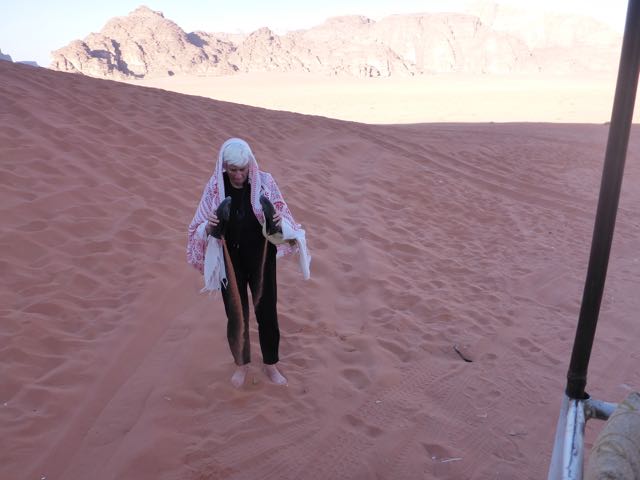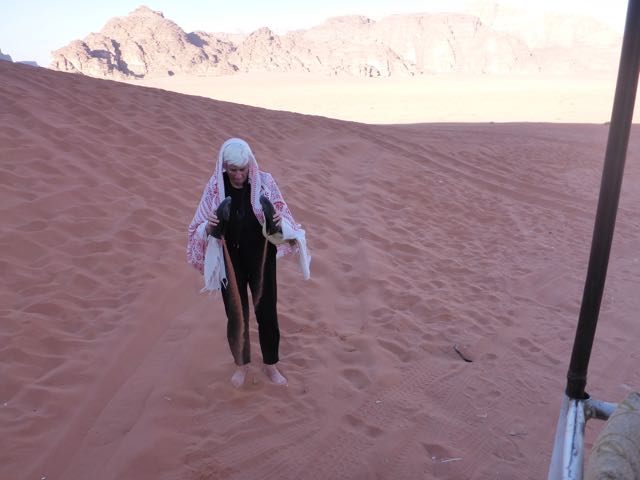Petra is a rock. Not an ordinary rock.
And it holds in it’s dusty, dry hands, the curious enormous tombs cut into rock hills and mountains from the top that now make up an attraction that draws not only archaeologist but tourists on pilgrimages or not to Jordan. Who hasn’t seen photos of what is called The Treasury, or the curious formations of boulders of sandstone, sometimes with a slight orange or pink color, against a taffeta blue sky that entice one to go deeper into the openings to see how life and death were once expressed, in a time 50 BC, when the Nabateans engaged with Egyptian, Roman and Assyrian civilizations. Once a quarry to hew out stones to build houses – Petra became quite an extended Nabatean city, still evident, where family burials were major and monstrous.

My Ride
There are various ways to manipulate the long two and a half mile trail: walk, ride a horse half way, ride a donkey, or ride in the crude buggy drawn by a small horse all the way if you can convince the driver with a good fee. (There is a Horse clinic at the entrance.) The latter, I chose for the experience, was the bumpiest, roughest ride I’ve ever had, as the surely metal wheels of the carriage bounced over what looked like cobblestones gone maniac, huge, nothing much flat about them, and popping up around corners to take away the comfort of the dusty trail. The first awesome moment, after weaving through what is called the As Sig, formed, of course, by water over the centuries, a narrow pathway through the rock mountains and me holding on for dear life as the driver barreled through like a Indy driver, opens up into the most treasured piece, The Treasury, constructed in the 1st century BC, 40 meters high, decorated with Corinthian capitals, friezes, figures and funerary urns which hides somewhere a pharaoh’s treasure. I don’t step into caves or tombs, but some do and they have plenty of possibilities along the street of facades on the way to the Royal tombs.
Here and there are plenty of vendors offering bottles of colored sand as an art form, little boys peddling pebbles from the quarry, plenty of head gear, (the son is HOT when one is not crunched in the narrow passageways of the dirt paths) and most fun, the vendors of spices. Now that’s a thrill. I stepped into one tight booth to sit on a wooden plank while the owner passed every kind of spice odor either under my nose, or rubbed it on my arms and hands from small soap-like bars. Frankincense and myrrh(the real thing!!), musk from gazelles, orange and whale, amber, wood from Yemen, rose, smells I’ve never smelled, in various forms – powder, soap, even little balls that could make one’s day sensually radiant. And then you are at the foot of the Royal Tombs, four huge blocks, facades, which were owned by families and heirs, obviously of wealth, and contain small burial chambers, a characteristic of the Byzantine times in 446 AD. For the extreme hikers, there are challenging hikes up major rocks and boulders where one can scrunch into other caves and tombs. And finally, bouncing like agitated balloons, we past the Great Temple, 7000 meters big, and our chestnut horse huffing under his blanket (in this heat), we reached Ad Deir, the Monastery, where altars still stand that were used as a Biclinium for meetings of religious groups and was later used as a chapel for Christians, so there are crosses carved into the rear wall.
Another experience, for I was fascinated how the men tie those huge scarves on their heads, was to have one of them (the young dark Nabateans with black eyes and black mustaches and long curly black hair) give an impromptu lesson, which I did, and felt pride when I was able to do my own. Using my own white and red scarf, I kept it on and found that it really cooled my head and I could flip one part of it own around my neck before the sun roasted it. Red and white scarves denote Jordan and black and white, Israel. The red and white colors were imposed on the Jordanians by the military by the British Empire and is based on colors used in the War of the Roses.
Since we were only two days in Jordan, we spent a lot of time in the car on the road required to reach Wadi Rum, one of the great sandy valleys surrounded by enormous rock mountains of a different sort. They are granite and sandstone formed by the sea and as the water evaporated it left strange marks that look like caramel (or chocolate) melting off of layers of rocks. They are a sight to behold, and the trick is to be in them or near them when the sun rises and sets. Of course, I had to ride a camel, and this time was for about 45 minutes,not just for a photo shoot. I was getting comfortable for the long haul, awakening muscles not used to this, but the Jordanian guide said I was riding him like a horse, not like a camel. (?). The camel owner was a small child who was more interested in hanging our with his friends than keeping the camels in line, moving on, as they grabbed for anything green to eat. I love the faces of camels. They seem so curious but snobby. Funny creatures and not a bad ride once you get used to it.
After the camel, we took off on another unbearably rough ride in a well-worn, small truck, a four wheeler, sitting in the back part where the wind tightened one’s face as I held on for dear life. This was even more rough than the morning horse carriage, and it went on forever and ever, as we stopped at a few “sights” in the rocks (the usual pictographs and petroglyphs,} one stop being a four story-sized red sand dune up which people tried to climb and then slide down. I got up about 10 feet and said, that’s it, then sat there and prayed for awhile before taking off my shoes and sliding down on my feet. Felt good.
We continued to move in one direction until about a half hour before the sun set. It was a far distance before we reached a Bedouin home, so remote, I wondered why. Bedouins live far a part but everyone gets along and anyone of the extended family might drop in for dinner. The Bedouin who had driven us across the desert, has quite a stock of thick wooled sheep and goats, which were rounded up (in a giant cloud of dust) and brought into the pen (yes, a metal pen out there in nowhere), for the night. We were invited in for a meal – an upside down dish called Maqlubah made of rice, chicken, onions, potatoes, carrots which is popular in these parts and cucumber salad of some sort and, of all things, peas and carrots (they thought I was British. Alas.). And the sun set over the distant mountains, and then began the ride back to the spot where our car awaited on tarmac. We drove two hours in the dark back to the hotel, knowing we had to leave the hotel at 4 in the morning to cross the borders into Israel.










